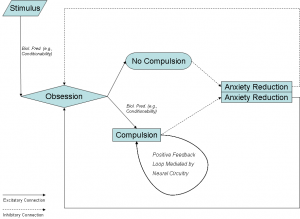Exposure & Response Prevention (ERP) for OCD: Treatment Mechanism
Posted by Steven J. Seay, Ph.D. in ERP, Obsessive-compulsive disorder (OCD)
Obsessions and compulsions in OCD are related via a positive feedback loop.
Question: How does ERP work? What mechanism underlies it?
Obsessive-compulsive disorder (OCD) is characterized by obsessions and compulsions. Obsessions are disturbing thoughts, images, or impulses that increase feelings of anxiety. Compulsions (also known as “rituals”) are the strategies that individuals with OCD use to reduce the anxiety associated with obsessions. Rituals are effective coping strategies in the short-term, in that they lead to fairly rapid decreases in anxiety. However, rituals are considered maladaptive, because the anxiety relief they bring is short-lived. Engaging in rituals ultimately increases the likelihood that obsessions will be re-experienced in the future. This can be thought of as a positive feedback loop, in which compulsive behavior indirectly reinforces obsessions. This is depicted in the bottom half of the included figure.
The treatment of choice for OCD is exposure and response prevention (ERP), which not surprisingly, has two main components: 1) exposure, and 2) response prevention. Response prevention refers to purposefully inhibiting one’s rituals, whereas exposure refers to willingly entering situations that are likely to trigger obsessions. Both exposure and response prevention elements are necessary for making meaningful treatment gains.
Response prevention is the critical component in “short-circuiting” the positive feedback loop in OCD. When one implements regular response prevention, obsessions are no longer reinforced and ultimately decrease in frequency and intensity. This is represented in the upper half of the included figure. Purposeful exposure provides further opportunities to break this cycle. The more exposures you complete, the more the positive feedback loop degrades. Eventually, with enough practice, you will become immunized to many of your triggers.
Some people get very stressed out at the prospect of completing exposures. They think, “How could I possibly do an exposure? I’m anxious enough as it is!” This sentiment is most common prior to initiating treatment and quickly fades once the individual begins practicing regular exposure. If you feel this way, keep in mind that if you complete structured exposure according to a hierarchy of feared situations (e.g., using subjective units of distress [SUDs] ratings), the process is less likely to feel stressful and overwhelming.
Questions? Comments? Sound off below. …or continue the discussion on Facebook, Twitter, or Google+.



